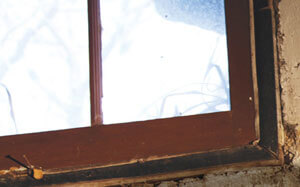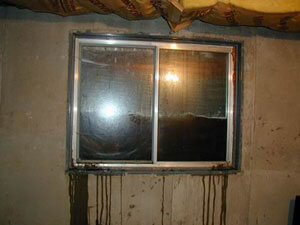Leaky basement window wells
Most homes with basements have windows, and these windows are housed inside of window wells. A window well's job is to act as a barrier that holds soil back from the space around the window. This makes it easier for light and air to enter the basement environment. There are numerous window well styles available on the market, and some even have a terraced surface inside of them which makes it easier for individuals inside the home to climb out to ground level in case there is an emergency preventing them from getting out through the first floor.

Window wells are made from durable materials, usually a hard plastic or vinyl. The materials are designed to last for years, but it's not the window well surface that causes leaks into the basement. Most wells are built to include a drainage system. When it rains, or when there is melting snow on the lawn, precipitation flows into the well. If there is no drain in place, moisture will build up next to the basement windows, eventually breaking the seal around the frame and getting into the home. However, this can also be the case of the drain is clogged.
A window well clog is not all that uncommon, and the flow of water through the drainage system can be obstructed by leaves, twigs, rocks, pine cones, seed pods, acorns, lawn trimmings, and by various other types of outdoor debris. When this happens, moisture cannot drain out like normal and it continues to pool up inside of the well where it will eventually start to trickle in through the weakened window's frame.
Warning Signs of a Leaky Basement Window Well

If you notice any of the following, then you likely have a leak coming through your window:
- Water can be seen trickling down the basement walls.
- Damage or staining can be seen on the walls, or on the floor under the window.
- Puddles of water form underneath the window.
- Noticeable mold growth on wall surfaces, or on the floor.
Inspecting Your Window Wells
Here are some things you can do on your own when it comes to inspecting your wells for a problem.
- Take a close, thorough look at all of your basement windows to see if there is any damage, such as holes, cracks, or chips in the framing. This should be done from inside and outside of the home.
- Make note of windows with damage by writing down the problems that you see, as well as where the window is located - i.e. front of the home.
- Test the drains by pouring a bucket of water into the well. If water flow is normal through the drainage system, then your basement leaks could be coming from something else.
- If water flow is not normal, make sure there is nothing in the way of the drain itself. Remove branches, rocks, leaves, etc. from the top of the drain and perform the test again.
- If the problem persists, look inside of the drain to see if you are able to see where the clog exists.
Preventing a Wet Basement
To take care of the problem or prevent it altogether, it is recommended that you have a window well cover installed over the wells to keep them safe and protected from harm. A well-built well will still allow water to get inside, but it won't let in any outdoor debris or animals which could clog up the drainage system. There are a wide variety of well covers available on the market, and most of them are clear. This means that a homeowner can still enjoy natural light and air flow into this space below their house.
You also have the ability to purchase custom-fitted well covers that are designed exclusively to fit over the exact dimensions of the wells you already have installed. Regardless of which type of cover you choose, they can usually be installed fairly quickly, and they have reinforcements inside of them, typically steel, which will be able to stand up tough to whatever Mother Nature has to throw your way. A window well cover is an important part of any home's overall waterproofing system.
Installation of New Window Well DrainsIf you need new drains installed, below is the installation process:
- Your window wells will be cleaned out extensively from the outside, and it will be filled with clean stone and a grate.
- A drain hole is drilled through the basement wall underneath the window will.
- The grate is installed on the outside over the hole.
- The drainage system is led through the hole, into your home, and into a sump pump system.
Another option to take care of this common problem would be to get replacement windows installed. If you have old, deteriorating basement windows, water could be getting inside through a brittle and weak frame. There are a variety of window styles available, including glass block.
